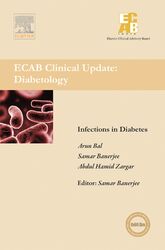「重要なお知らせ:日本語書籍をご購入いただき、eLibraryをご利用の皆さまへ」
エルゼビアは、より快適にサービスをご利用いただくため、システムの重要なアップデートを実施いたします。
現在、新サイト、eBooks+への移行が進められています。
新規ユーザー登録および書籍の登録はElsevier eLibraryでは停止しております。
12月15日以降に
こちらよりご利用・ご登録ください。
Book Description
Patients with diabetes are predisposed to infections. The risk ratio for infectious disease-related hospitalization for diabetic versus nondiabetic persons is more than 2, and almost 2 for death attributable to infection. Infections in diabetes may precipitate metabolic derangements and, conversely, the metabolic derangements of diabetes may facilitate infection. Abnormalities in the microvascular circulation of individuals with diabetes may result in decreased tissue perfusion, which facilitates the acquisition of infection and impairs response to therapy.
The incidence of TB among diabetic patients is 2–5 times higher when compared to the general population, which recently has raised the concern that a combination of DM and HIV infection might lead to a further increased
incidence of TB in India and in other developing nations. However, it is unclear whether diabetes is an independent risk for common upper and lower respiratory tract infections.
Urinary tract is also reported to be the most prevalent site of infection in patients with diabetes. These infections are known to account for a relatively smaller percentage of reported patients probably due to the fact that most patients, including diabetics, with urinary tract infection are treated as outpatients. A number of long-term effects of diabetes mellitus on the genitourinary system predispose diabetic patients to bacterial urinary tract infections. In addition, complications of urinary tract infection (e.g., bacteremia, renal abscesses, and renal papillary necrosis) are more common in patients with than without diabetes.
Rhinocerebral mucormycosis and emphysematous pyelonephritis are some of the less commonly reported conditions seen in diabetics though being important pathologies. The primary goal of this book is to provide a high-quality, evidence-based text on the various aspects of the associations of various infections in diabetics with prime focus on TB and diabetes, rare conditions such as rhinocerebral mucormycosis and emphysematous pyelonephritis and also the various acute infections commonly reported in the condition. The book includes in-depth analysis of the diagnostic and management issues considering the same.


 (0 rating)
(0 rating) 





